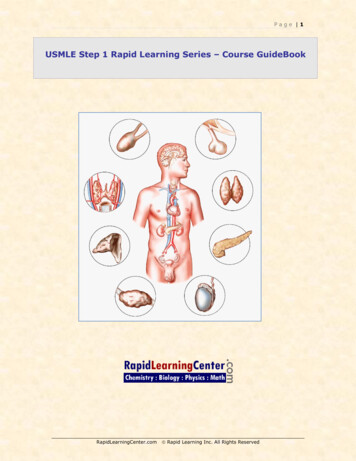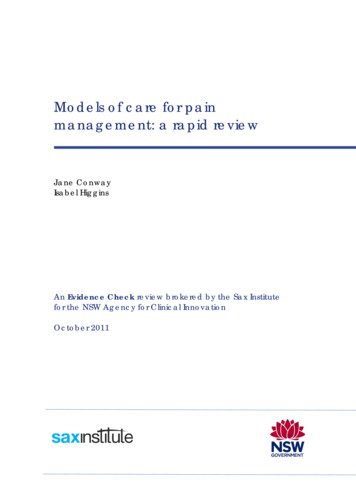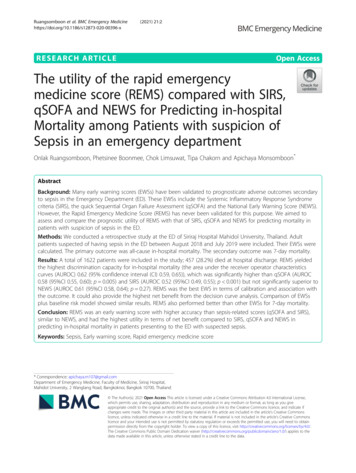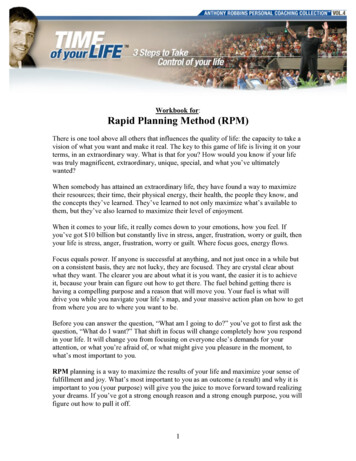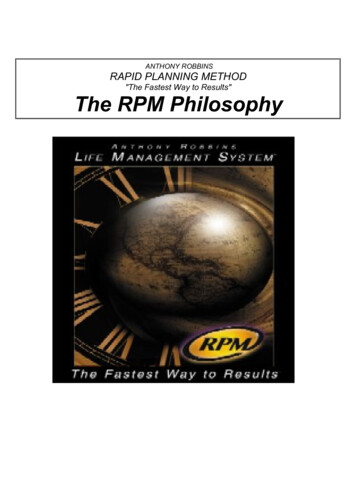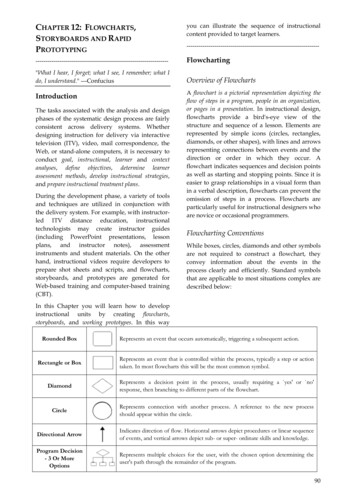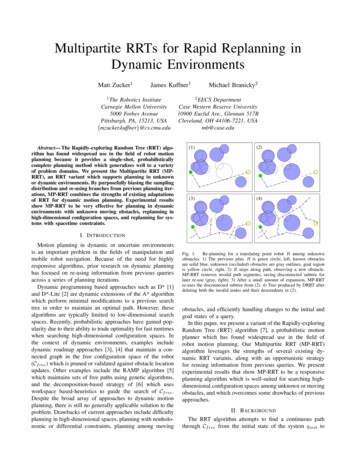
Transcription
Multipartite RRTs for Rapid Replanning inDynamic EnvironmentsMatt Zucker1James Kuffner11The Robotics InstituteCarnegie Mellon University5000 Forbes AvenuePittsburgh, PA, 15213, USA{mzucker,kuffner}@cs.cmu.eduAbstract— The Rapidly-exploring Random Tree (RRT) algorithm has found widespread use in the field of robot motionplanning because it provides a single-shot, probabilisticallycomplete planning method which generalizes well to a varietyof problem domains. We present the Multipartite RRT (MPRRT), an RRT variant which supports planning in unknownor dynamic environments. By purposefully biasing the samplingdistribution and re-using branches from previous planning iterations, MP-RRT combines the strengths of existing adaptationsof RRT for dynamic motion planning. Experimental resultsshow MP-RRT to be very effective for planning in dynamicenvironments with unknown moving obstacles, replanning inhigh-dimensional configuration spaces, and replanning for systems with spacetime constraints.Michael Branicky22EECS DepartmentCase Western Reserve University10900 Euclid Ave., Glennan 517BCleveland, OH 44106-7221, USAmb@case.edu(1)(2)(3)(4)I. I NTRODUCTIONMotion planning in dynamic or uncertain environmentsis an important problem in the fields of manipulation andmobile robot navigation. Because of the need for highlyresponsive algorithms, prior research on dynamic planninghas focused on re-using information from previous queriesacross a series of planning iterations.Dynamic programming based approaches such as D* [1]and D*-Lite [2] are dynamic extensions of the A* algorithmwhich perform minimal modifications to a previous searchtree in order to maintain an optimal path. However, thesealgorithms are typically limited to low-dimensional searchspaces. Recently, probabilistic approaches have gained popularity due to their ability to trade optimality for fast runtimeswhen searching high-dimensional configuration spaces. Inthe context of dynamic environments, examples includedynamic roadmap approaches [3], [4] that maintain a connected graph in the free configuration space of the robot(Cf ree ) which is pruned or validated against obstacle locationupdates. Other examples include the RAMP algorithm [5]which maintains sets of free paths using genetic algorithms,and the decomposition-based strategy of [6] which usesworkspace based-heuristics to guide the search of Cf ree .Despite the broad array of approaches to dynamic motionplanning, there is still no generally applicable solution to theproblem. Drawbacks of current approaches include difficultyplanning in high-dimensional spaces, planning with nonholonomic or differential constraints, planning among movingFig. 1.Re-planning for a translating point robot R among unknownobstacles. 1) The previous plan. R is green circle, left, known obstaclesare solid blue, unknown (occluded) obstacles are gray outlines, goal regionis yellow circle, right. 2) R steps along path, observing a new obstacle.MP-RRT removes invalid path segments, saving disconnected subtree forlater re-use (gray, right). 3) After a small amount of expansion, MP-RRTre-uses the disconnected subtree from (2). 4) Tree produced by DRRT afterdeleting both the invalid nodes and their descendents in (2).obstacles, and efficiently handling changes to the initial andgoal states of a query.In this paper, we present a variant of the Rapidly-exploringRandom Tree (RRT) algorithm [7], a probabilistic motionplanner which has found widespread use in the field ofrobot motion planning. Our Multipartite RRT (MP-RRT)algorithm leverages the strengths of several existing dynamic RRT variants, along with an opportunistic strategyfor reusing information from previous queries. We presentexperimental results that show MP-RRT to be a responsiveplanning algorithm which is well-suited for searching highdimensional configuration spaces among unknown or movingobstacles, and which overcomes some drawbacks of previousapproaches.II. BACKGROUNDThe RRT algorithm attempts to find a continuous paththrough Cf ree from the initial state of the system qinit to
some state qgoal G, a set of valid goal states. Paths indexedby time will be referred to as trajectories. The original RRTalgorithm begins by initializing the search tree T to its rootqinit . Then the following steps are repeated until a valid pathis found, or the progress reaches another termination criterion(e.g., a specified time or memory limit is exceeded or thealgorithm has reached a maximum number of iterations):A configuration qnew C is selected at random. Then itsnearest neighbor in the tree qnearest is selected according toa scalar metric ρ(q1 , q2 ) 7 defined on C. Next, an edge eis generated which extends from qnearest towards qnew ; if elies in Cf ree , then the terminal point of the edge (often qnewitself) is inserted into T as a child of qnearest .Assuming uniform sampling of C, the RRT algorithm isbiased to quickly construct paths into unoccupied Voronoiregions of the vertices of T leading to a rapid exploration ofCf ree [8]. One simple enhancement to this algorithm entailsadding a “goal bias” to the search by choosing some goalconfiguration qgoal G as the sampled state qnew with smallprobability pgoal for each iteration. In practice, this yieldsmuch faster convergence than simply waiting for a randomsampler to select states in G.A. The dynamic planning problemDynamic planning is similar to static motion planning,with the modification that planning steps will be alternatedwith system and world update steps. Applications for dynamic planning include navigation or manipulation planningin a world with unknown or moving obstacles. Between planning iterations, several possible events may have occurredsimultaneously: 1) The robot may have moved, and in doingso may have discovered new obstacles to avoid. 2) The goalmay have moved. 3) Previously sensed obstacles may havemoved independently of any action by the robot.More formally, there will be multiple planning iterationsto find a path through Cf ree from qinit to qgoal G; howeverwe do not require that the state qinit and the sets Cf ree andG remain fixed between iterations.One way to approach the dynamic planning problem is tosimply re-run the original RRT algorithm for every planningiteration; however, the world typically exhibits temporalcoherence which this naı̈ve approach fails to exploit. Whileall the obstacles and the goal region may have moved, itis quite possible that the changes are small enough that theplan from the previous iteration is still valid. In this case, theextra computation of constructing a new plan from scratchis inefficient.The intuition that information from previous planningiterations should be preserved led to the development of threemodifications to the RRT algorithm: ERRT [9], DRRT [10],and RRF [11]. In ERRT, when a successful plan is generated,the states along the path from qinit to qgoal are inserted into awaypoint cache which is then used to bias random selectionfor the next planning iteration. At the start of the nextiteration, the previous RRT is discarded, but qnew will beselected from the waypoint cache with probability pwaypoint .In practice, ERRT performs much better than naı̈ve iteratedRRT in the face of small changes to Cf ree and G becausestates which were used in a previously successful plan arelikely to be good intermediate states in the current plan.DRRT takes a different approach to exploiting temporalcoherence; whereas ERRT biases selection towards statesfrom the previous path, DRRT attempts to reuse branches ofthe previous RRT which lie in Cf ree and remain connected tothe root. The implementation of DRRT imposes a substantialoverhead at the start of planning: before the previous RRTcan be reused, it must be validated against any updates toCf ree . In practice, though, time spent on validation (i.e.,collision checking) enables the reuse of very large subtrees,up to the size of the entire previous RRT.Growing multiple trees backwards from a set of goalconfigurations has been shown to be efficient in the context of one-shot planning for redundant manipulators [12].Reconfigurable Random Forests (RRF) build a forest of disconnected RRTs for the purposes of multiple-query planning,with the aim of incrementally building a data structure thateventually captures the entire topology of Cf ree [11]. OurMP-RRT algorithm also uses a forest of disconnected RRTsfor multiple-query planning. However, we decided to insteadfocus the MP-RRT algorithm on a single start-goal pair, notonly because it yields a more responsive planner, but becausea tree structure that spans multiply-connected regions ofCf ree tends to yield significantly suboptimal paths which arein general not homotopic to the optimal solution.B. Point-to-point connectionsConsider a scenario involving a mobile robot with alimited sensing horizon, and in which G does not changesubstantially between planning iterations. In this case, itis advantageous for DRRT to plan in reverse, building atree rooted at qgoal G which connects to the currentconfiguration of the robot qcurrent . In such a scenario,modifications to Cf ree will typically take place in the vicinityof the robot configuration; therefore, a tree rooted at thegoal state will be able to reuse much more information fromprevious planning iterations than one rooted at the currentrobot configuration.For systems with momentum or nonholonomic constraints,backward planning introduces an additional complication:whereas ERRT and simple RRT only require that we generatean edge from qnearest towards qnew , planning backwardsrequires the ability to generate an edge exactly connectingsome node in the tree to qcurrent .When planning under differential constraints (i.e., generating trajectories for a nonholonomic robot), point-to-pointconnections may require solving a boundary value problemto generate the correct controls for a trajectory segmentexactly interpolating the endpoints. If no inverse dynamicsmodel for the system can be computed, the aforementionedalgorithms are difficult to use; even if such a model can becomputed, doing so may impose significant overhead on theplanning model.Like DRRT in the reverse planning scenario, our MPRRT algorithm requires the ability to make point-to-point
tyxStaticObstacleDeterministicPathFig. 2.BoundedVelocityBoundedAccelerationObstacles as spacetime volumesconnections; however, unlike the algorithms above, we anticipate that such connections may require significantly morecomputation than normal RRT extensions, and therefore ouralgorithm attempts to make point-to-point connections inan opportunistic and principled fashion. We believe guidingthe planning process to be “choosy” about point-to-pointconnections is a novel contribution that makes MP-RRT moreappropriate for certain classes of planning problems thanapproaches such as probabilistic roadmaps (PRM) or RRF.C. Moving obstaclesConsider the scenario in which the obstacles themselvesare moving through the workspace. One approach to solvingthe planning problem is to generate paths in CT C [0, ),where the additional dimension indexes time [13]. Then, aworkspace collision checker can use the time component t T of a state to check against predetermined trajectories orworst-case obstacle motion assumptions (see figure 2). Thiseffectively represents obstacles as spacetime volumes in theworkspace. In this formulation, updates between planningiterations may alter not only estimates of the current positionof an obstacle, but estimates of its future trajectory as well.Although convenient, the CT formulation places someinteresting restrictions on the class of planning algorithmswhich can be used. In particular, multi-tree approaches suchas Bidirectional RRT [7] or augmentation via local RRTs [14]may not be practical to implement because the precise timeto reach the goal may be undefined. In this case, G willspan a large (possibly infinite) interval on the t axis of CT .Given that there is no single goal state, we are faced withthe difficult question of where to root a second tree. PRMapproaches typically cannot be applied in a straightforwardmanner because the PRM spans C and not CT . Someapproaches [15] solve the problem with respect to staticobstacles in C only, before incorporating dynamic obstacleconstraints in CT . DRRT may suffer particularly in the CTformulation because it cannot plan backwards from the goal.If sensor updates happen in the vicinity of the robot, the validsubtrees reused between subsequent plans will be relativelysmall.III. T HE MP-RRT A LGORITHMWe present the MP-RRT algorithm, an RRT variant whichis well-suited for dynamic planning problems for mobilerobots and manipulators in environments with unknown ordynamic obstacles. Conceptually, MP-RRT combines thestrengths of biasing the sampling distribution towards previously useful states as in ERRT and analytically computingwhich segments of previous RRTs can be re-used as inDRRT.At the start of a given planning iteration, if there isno tree T from a previous iteration, or if the intital stateor goal region have changed substantially, MP-RRT buildsan RRT from scratch. Otherwise, the MP-RRT runs theP RUNE A ND P REPEND procedure (see accompanying pseudocode for the M P R RT S EARCH and P RUNE A ND P REPENDprocedures). During planning, MP-RRT maintains a forest F of disconnected subtrees which lie in Cf ree , butwhich are not connected to the root node qroot of T . InP RUNE A ND P REPEND, any nodes and edges of T and Fwhich are no longer valid are deleted, and any disconnectedsubtrees which are created as a result are placed into F .Procedure M P R RT S EARCH (qinit )Performs the MP-RRT algorithm.Data: T : the previous search tree, if anyF : the previous forest of disconnectedsubtreesqinit : the initial stateResult: a boolean value indicating plan successif E MPTY (T ) thenqroot qinit ;I NSERT (qroot , T );elseP RUNE A ND P REPEND (T, F, qinit );if T REE H A
complete planning method which generalizes well to a variety of problem domains. We present the Multipartite RRT (MP-RRT), an RRT variant which supports planning in unknown or dynamic environments. By purposefully biasing the sampling distribution and re-using branches from previous planning iter-ations, MP-RRT combines the strengths of existing adaptations of RRT for dynamic motion planning .



